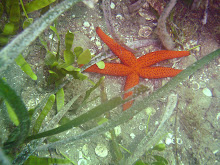The following is an article regarding rinse tanks on board SCUBA boats from Undercurrent.org. The travel season is upon us and there will be a lot of SCUBA related travel. Remember that sometimes the threat cannot be seen with your eyes or underwater camera!
Bacterial Contamination in Rinse Tanks
a new study says don’t dip your mask and regulator
from the June, 2009 issue of Undercurrent
Recreational divers typically rinse their equipment in “communal” tanks filled with fresh water after completing dives. Often all the equipment (wetsuits, booties, fins, BCDs, regulators with mouthpieces and masks) is rinsed in common tanks. In some facilities, a separate tank is provided for rinsing regulators. Masks are often rinsed and even stored in a common tank on boats before a dive.
Few studies have addressed the possibility that these communal rinse tanks may harbor pathogens and transmit disease. We first reported that communal rinse tanks at a dive facility in Roatan indeed contained significant levels of many types of microorganisms (Microbe, December 2007, p. 577). However, because that dive facility did not allow us to sample the water entering rinse tanks, we were unable to determine if the microorganisms originated from the water used to fill tanks or from equipment that was rinsed in the tanks.
Recently, a report documented the spread of conjunctivitis among divers using two dive boats off of Fiji’s Vitu Levu Island (Undersea and Hyperbaric Medicine, 2008 vol. 35, p. 169). Among 29 divers, 14 cases (almost 50 percent) of conjunctivitis were ultimately documented. The pattern by which conjunctivitis was spread among divers and between boats was consistent with the outbreak arising from the divemaster, a Fijian resident, who reported having an eye infection prior to the outbreak and who placed his own mask in the communal mask container (Undersea and Hyperbaric Medicine, 2008 vol. 35, p. 169). This study established that disease can be transmitted among scuba divers via communal tanks. (Read our interview with the study’s author in our September 2008 issue.)
In October 2007, we investigated the extent to which bacteria were introduced into communal rinse tanks, via water used to fill tanks and via dive equipment rinsed in them, and whether cleaning a rinse tank with bleach once a day reduced the subsequent bacterial population. A dive facility in Bonaire cooperated in this study but wished not to be identified.
Samples from boats returning from afternoon dives showed very high levels of many types of bacteria.
The facility had two rinse tanks for general equipment and one tank for regulators. Each morning for three days, at 7:30 a.m., one equipment rinse tank, designated “A” was emptied, scrubbed using undiluted bleach, then rinsed several times and filled with fresh water from a hose. The other equipment rinse tank, “B,” was emptied, rinsed several times with water and filled with water from the same hose but was not bleached. We did not empty, clean or fill the regulator rinse tank. During the day, dive staff would occasionally drain and refill equipment and regulator rinse tanks. Water samples were obtained from the three tanks three times daily: 8 a.m., 1 p.m. and 5 p.m. The samples were placed in a refrigerator until the day of departure, then put in a suitcase, placed in a refrigerator 12 hours later, and finally examined for colonies and photographed. Pictures of plates can be viewed as a PowerPoint presentation at http://www.hsc.wvu.edu/som/bmp/miller.asp - - click the “Bonaire 2007” link under the topic “Research.”
No bacterial colonies were observed from water samples filling the rinse tanks. The 8 a.m. water samples, immediately after equipment tanks were cleaned with bleach (A) or not cleaned with bleach (B) and filled with water, did not give rise to any colonies on all three days.
In contrast, 8 a.m. water samples in the regulator rinse tank contained a high level of bacteria on all days tested. Presumably the regulator rinse tank had been used to rinse regulators the previous day and after night dives. At 1 p.m. and 5 p.m., rinse tanks A, B and the regulator rinse tank usually showed high levels of bacterial contamination. Cleaning tank A with bleach did not reduce the subsequent bacterial level. In several instances, water samples showed low levels of bacteria -- this was apparently because the tanks had been recently drained and refilled. It was only possible to obtain water samples from two mask rinse tanks, both at 4 p.m., as boats were returning from afternoon dives. Both of these samples showed very high levels of contamination by many types of bacteria.
Our studies show that bacterial contamination of divers’ rinse tanks at this Bonaire facility was introduced by rinsing equipment, not by water used to fill tanks. Presumably, other potential pathogens, like viruses, are also introduced into the rinse tanks. If divers with a communicable illness (like conjunctivitis, the “common cold,” infectious mononucleosis, diphtheria and streptococcal infections) rinse equipment in a tank, people who rinse after them may pick up the transmitting microorganism and become infected.
We conclude that, if possible, scuba equipment, especially mouthpieces and masks, should be rinsed well with fresh water or alcohol swabs rather than in communal tanks, to reduce the potential of spreading or contracting disease. Studies are now in progress to identify the bacteria that inhabit the rinse tanks.
Michael R. Miller is a professor of biochemistry at West Virginia University, and Tammy S. Miller is senior office administrator of the department of microbiology and immunology at West Virginia University.








No comments:
Post a Comment
Welcome Diver! Please stop in and share your thoughts or experience with us all.
Thank you for commenting. Active participation is what keeps our group alive!